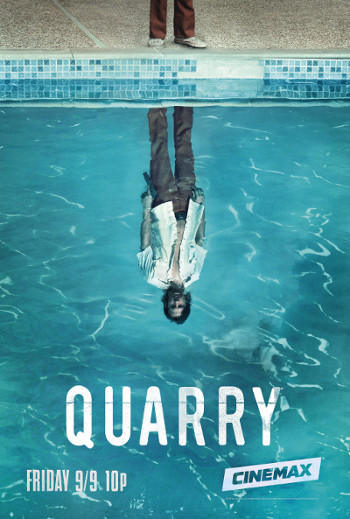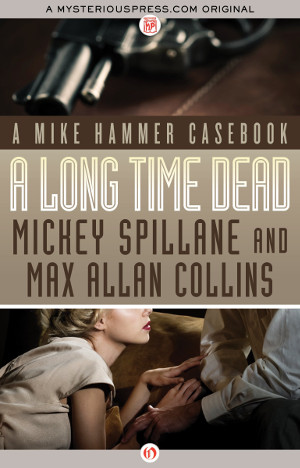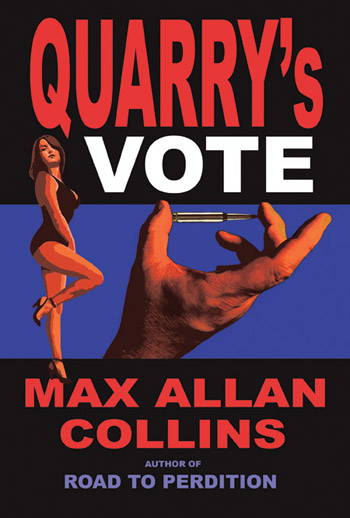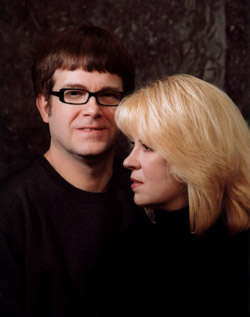
How bizarre it seems – in a sense, it hasn’t registered – that the novel I began at the University of Iowa’s Writers Workshop in late 1971 has spawned a 2016 TV series.
My instructor, William Price Fox, didn’t like it. Most of the class didn’t, either. But several smart people thought the first two chapters of QUARRY were the best thing they’d ever read in a Workshop class. Fox, a writer I admired, was spotty as a teacher. He shared some good stories about his Hollywood perils, but he also spent several classes reading his own stuff to us. The class was only two hours once a week, and I had to drive from Muscatine (forty miles) to attend. I thought then that Fox reading his own work was lazy and self-indulgent, and I still do. But he did teach me the “Indian behind a tree” concept (ask me sometime).
A week or so after my Workshop class with its mixed reviews of QUARRY’s first two chapters, I sold my first novel, BAIT MONEY, and, a couple of weeks later, I sold the second one, NO CURE FOR DEATH. Both were written at the Workshop when Richard Yates was my teacher and mentor – a great writer and a great guy. The NYC editor wanted sequels to both, so I put QUARRY aside (probably a third of it written) and proceeded with THE BABY BLUE RIP-OFF and BLOOD MONEY. I had graduated in early ‘72 by then.
Then I got back to QUARRY, probably in ‘74, and it sold in ‘75 and was finally published in ‘76 (initially published as THE BROKER).
How vividly I remember sitting in my office in our apartment in downtown Muscatine (over a beauty shop – the smells wafting up were not heavenly) and pounding away at those early books. I thought QUARRY was the best thing I’d come up with, as the Nolan books were glorified Richard Stark pastiches and Mallory was just me filtering my private eye jones through an amateur detective. QUARRY was something original. I was going places! This would, in a good way, leave a mark.
And at first it seemed it would. The editor wanted three more novels about the character, and of course I eagerly complied. By the fourth book, two things were obvious – QUARRY was not setting the world on fire, and I was having trouble keeping the black-comedy element from spinning out of control. THE SLASHER seemed to me over-the-top, or anyway a subsequent novel would have been.
That doesn’t mean I wasn’t disappointed that no more books were requested by the editor. But the QUARRY series seemed, at four entries, to be complete. I was going places, all right – back to the typewriter to try again.
But a funny thing happened on the way to obscurity – a small cult of interest arose in QUARRY. Smart people like Jon Breen, Ed Gorman and Bill Crider said nice things about the books. The series started getting fan letters. So when I had some success with the Nate Heller novels, I decided to do just one more QUARRY – and I did, PRIMARY TARGET (since re-pubbed as QUARRY’S VOTE). The book was well-received, but that was the end of it.
The end of it, anyway, till the new millennium dawned and a young filmmaker named Jeffrey Goodman came knocking, and a new publisher/editor named Charles Ardai got in touch. From Goodman’s enthusiasm for the QUARRY short story, “A Matter of Principal,” came an award-winning short film written by me, and then a feature-length version co-written by me, THE LAST LULLABY. More or less simultaneously, Ardai asked me to do a QUARRY novel for his new retro-noir line, and I jumped at the chance to give the series a real ending – THE LAST QUARRY, a novelization of my version of the screenplay of the Goodman feature.
The surprisingly strong response to THE LAST QUARRY resulted in a conversation between Ardai and me that went something like this:
“I wouldn’t mind you doing another QUARRY for us,” he said.
“I wouldn’t mind myself.”
“But you ended the series. What book can you write after you’ve done THE LAST QUARRY?”
“Why not…THE FIRST QUARRY?”
Now we’re at eleven novels – QUARRY IN THE BLACK next month – and, after a somewhat rough birth going back to 2012, the QUARRY TV series will debut on Cinemax this Friday, at 9 pm Central time.
I’ve seen all eight episodes and they are excellent. It’s essentially an extended origin story of how returning Marine Mac Conway (the character’s real name, according to the show anyway) becomes hitman Quarry. Michael Fuller and Graham Gordy, the creators of the series, initially did not reveal the character’s “real name,” but it became clumsy for the lead character not to have, well, a name. They dubbed him “Mac” after me – M.A.C. Nice gesture.
And they were smart enough to set the show in the early ‘70s. It’s a nice fit with my current approach, which is to do my new QUARRY novels in ‘70s/‘80s period. You know you are old when a series you began as contemporary is now historical.
So I hope you like the TV series. If you don’t, and are a fan of the books, pretend to, will you? If the show becomes a hit, I may get to write more QUARRY novels.
Stranger things have happened.
Also this week, the Mike Hammer short story collection, A LONG TIME DEAD, will become available in print and e-book editions from Mysterious Press. This is an exciting project for me, as it represents the first collection of Hammer stories, and possibly the last, since I have exhausted the shorter fragments in the Spillane files.
My sincere thanks to Otto Penzler for publishing it. Otto, who edited and published the first three posthumous Hammer novels, has been a great friend to Mickey, Mike Hammer and me.
The advance reviews for the QUARRY TV show are strong, like this one.
And this one.
Here QUARRY is seen as one of the nine best shows of the fall season.
And here it’s seen as one of the ten best shows.
You’ll enjoy this interview with Michael Fuller, half of the creative team behind the writing of the QUARRY series.
Here’s a nice write-up on the forthcoming QUARRY comics mini-series.
Check out this terrific review of the Hammer novel, MURDER NEVER KNOCKS.
And, finally, here’s a positive review from Kirkus, of all people, for A LONG TIME DEAD.
M.A.C.








 This is going to be a brief update this week, because Nate has a busy week in Japan.
This is going to be a brief update this week, because Nate has a busy week in Japan.  Antiques Bizarre, the fifth book in our Trash ‘n’ Treasures mystery series from Kensington, will be hitting the stores this week. This latest collaboration between Al and me, under the name Barbara Allan, is more of a who done-it than the previous books, but there is still plenty of turmoil in the personal lives of Prozac-popping Brandy Borne, bi-polar Mother, and their blind, diabetic dog Sushi. The mystery revolves around the auction of the newly discovered last Faberge egg that had been commissioned by the Russian Tsar, its disappearance and the death of the buyer.
Antiques Bizarre, the fifth book in our Trash ‘n’ Treasures mystery series from Kensington, will be hitting the stores this week. This latest collaboration between Al and me, under the name Barbara Allan, is more of a who done-it than the previous books, but there is still plenty of turmoil in the personal lives of Prozac-popping Brandy Borne, bi-polar Mother, and their blind, diabetic dog Sushi. The mystery revolves around the auction of the newly discovered last Faberge egg that had been commissioned by the Russian Tsar, its disappearance and the death of the buyer. Since then, Al and I have collaborated on other short stories, two stand-alone novels, and – having confidence that the marriage would hold – signed a five-book contract. Our Trash ‘n’ Treasures mysteries – the first of which, Antiques Roadkill, came out from Kensington in fall of ‘06 – have a female voice, with back story that leans more on my life than Al’s, although the antiquing aspect is a shared interest.
Since then, Al and I have collaborated on other short stories, two stand-alone novels, and – having confidence that the marriage would hold – signed a five-book contract. Our Trash ‘n’ Treasures mysteries – the first of which, Antiques Roadkill, came out from Kensington in fall of ‘06 – have a female voice, with back story that leans more on my life than Al’s, although the antiquing aspect is a shared interest.